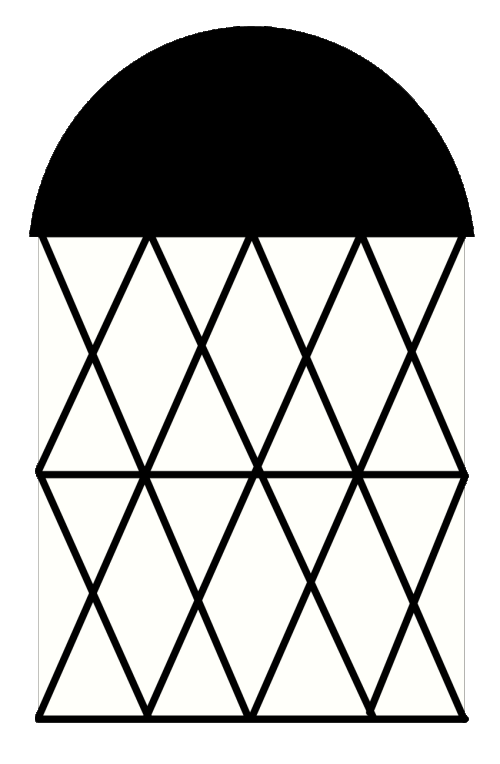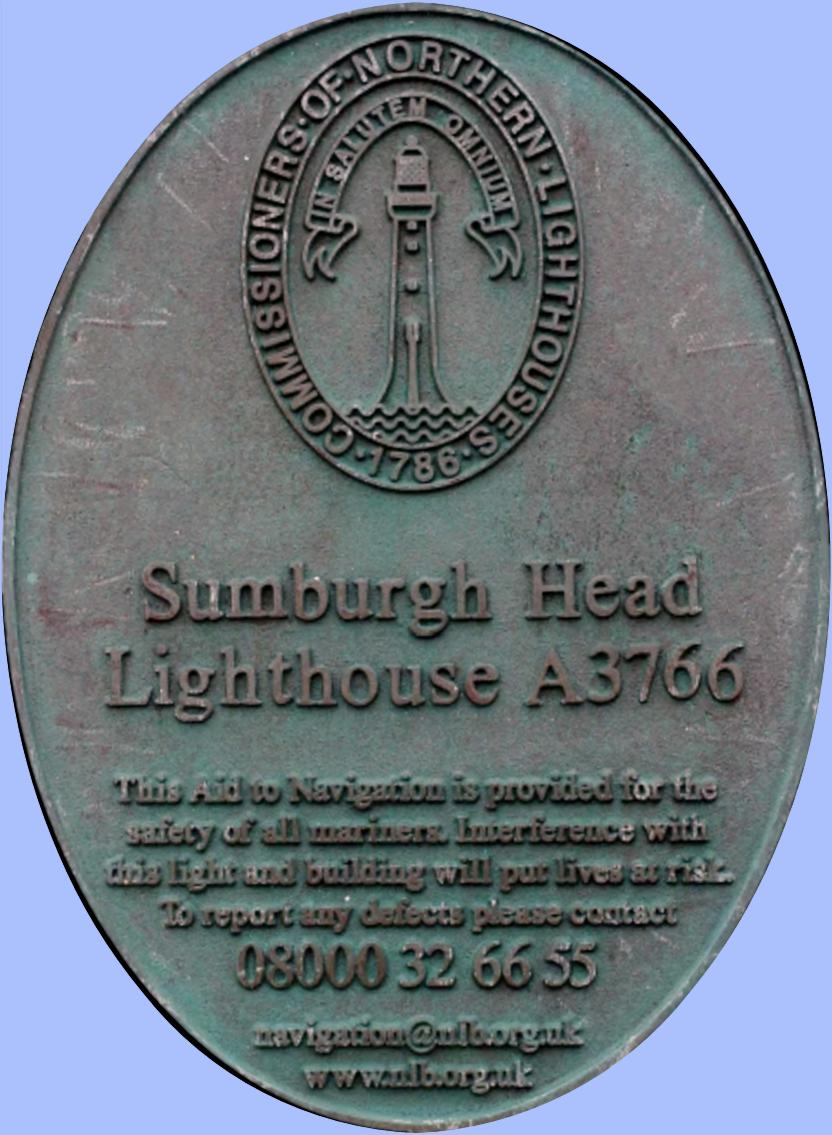
Place of the lighthouse
Building of the Lighthouse
Warning systems (Light, Fog horn, Radar Beacon)
1st.order catodioptic lens-mercury bath Wind 30 mins Installed 1914 Metal Halide 250 watt lamp
Operational status
Information about the lighthouse specific
Additional information
Description Robert Stevenson, 1821, with additional buildings of later 19th century and 1905. Complex of lighthouse buildings on sloping promontory site including original tower with flanking pavilions (keeper's accommodation), engine house and additional building adjacent to S, and horn house to E. All buildings with harled walls, and stugged and droved ashlar dressings, all painted. Base and eaves courses, margined openings and projecting cills. TOWER AND KEEPER'S ACCOMMODATION: symmetrical arrangement comprising 2-storey, 3-bay classical pavilions flanking battered circular tower on single storey podium between. Tower; narrow 8-pane timber sash and case window to E, oculi to E and W at floor above. Balcony with cast-iron handrail corbelled out over moulded cornice, metal murette with vertically-boarded timber door to domed lantern containing revolving reflector. W (PRINCIPAL) ELEVATION: central door in podium wall, stone stair rising to flagged tower base at 1st floor level. Centre bay of pavilions slightly advanced, vertically-boarded timber doors with brass handles at ground flanking centre, regular fenestration in centre and outer bays at 1st floor, inner bays blank. Ashlar-coped rubble retaining wall extending to left, surmounted by hooped wrought-iron railing. E ELEVATION: symmetrical, tower at centre flanked by battered screen walls with margined doorways and corniced wallheads; single storey (lower floor concealed) 3-bay pavilions flanking, centre bay advanced, now obscured by modern additions (1996); regular fenestration in flanking bays. 12-pane timber sash and case windows. Flat roofs with cast-iron corniced gutters and downpipes. Paired stugged ashlar octagonal stacks centring pavilion roofs; square bases swept up to octagonal shafts with corniced copes and circular cans. ENGINE HOUSE: Single storey, 8-bay flat-roofed block. Long and short dressings and projecting cills to windows. E ELEVATION: 8-bay elevation, 2-leaf vertically-boarded timber door with glazed uppers and 2-pane fanlight at centre. 3-bay engine room to left, wide 2-leaf vertically-boarded timber door in centre bay, regular fenestration in flanking bays. Matching windows flanking vertically- boarded timber door with 2-pane fanlight in bays to outer right, additional plate glass window to left. N ELEVATION: blank. S ELEVATION: 2 bays with windows matching W elevation. W ELEVATION: asymmetrical 8-bay elevation, small flat-roofed porch and window flanking centre to left and right respectively, regular fenestration in flanking bays except for smaller window in penultimate bay to left. Timber sash and case windows, principal windows with 2-pane lower sashes and 6-pane upper sashes; plate glass to other openings. INTERIOR: Engine room to S, decorative tiled floor, tiled dado, machinery and tanks by James Dove & Co of Edinburgh 1906. SW BUILDING: symmetrical 2-storey, 3-bay flat-roofed block. E ELEVATION: blank centre bay, vertically-boarded timber doors in outer bays, additional small square plate glass fixed-light to outer left; 12-pane timber sash and case windows at 1st floor. W ELEVATION: 2-leaf vertically-boarded timber door centred at ground, 4-pane timber sash and case window in bay to left, blind window in bay to right, 12-pane fixed-light only centred at 1st floor. Harled wallhead stack centring side elevations; coped with circular cans. SUNDIAL: bollard-like cast-iron plinth to sundial (now removed 1996) comprising square stone base with tapered and fluted shaft corniced at top. FOG HORN HOUSE: 2-tier tower comprising battered semi-circular plan concrete plinth with vertically disposed rivetted cast-iron oil tanks against W elevation; cast-iron ladder at left, rising to platform with semi-octagonal flat-roofed upper tier; cogged track on wallhead supporting rotating horn. BOUNDARY WALLS AND GATEPIERS: flagstone rubble boundary wall, partially harl-pointed and whitewashed with wrought-iron gate to S and W. Stugged and droved square gatepiers with pyramidal caps to principal entrance; matching piers flanking gate to E. 2-tier retaining wall bounding SE side of approach road; walls flanking lower end of approach road terminated by matching gatepiers. Statement of Special Interest Shetland's first lighthouse, built on the site of an ancient fort. It is sited on Sumburgh Head as dramatically as a castle, particularly when approach by road from the north, or by sea from the south. Stevenson's starkly formal design contrasts with the rugged imformality of the site. Other than the lantern dome, and later infilling of the outer first floor windows, the W elevation remains as in his design drawing. As such, this is one of Scotland's finest surviving pieces of early 19th century architecture. associated engineer Robert Stevenson date January 1819 - 1821 era Georgian | category Lighthouse | reference HU406078 photo © Nicholas Mutton and licensed for reuse under this Creative Commons Licence The remote Sumburgh Head Lighthouse at the southern tip of Mainland Shetland was the first constructed in the islands. It was the work of Scottish engineer ROBERT STEVENSON (1772-1850), who headed a family of famous lighthouse builders. Now automated, it remains operational and its keepers' cottages provide visitor accommodation. Sumburgh Head Lighthouse occupies a high rocky headland exposed to harsh weather and turbulent seas. It was the seventh lighthouse designed by Stevenson in his capacity as engineer to the Northern Lighthouse Board (appointed 12th July 1808). Constructed in 1819-21, the three storey tower is flanked symmetrically by flat-roofed two storey pavilions — dwellings for two lighthouse keepers and their families. A walled courtyard lies between the pavilions, with the tower on a podium midway along the its seaward side. The tapering circular masonry tower is 17.1m high, with an internal staircase of 52 steps leading from ground level to the light. The walls are double thickness to protect against the weather. For the same reason, all the masonry buildings on site have harled walls — the stone is covered with lime render embedded with small stones. They are also painted white. The original lantern (now replaced) was in the form of a cupola,and was probably lit by a mineral oil lamp. A cantelvered balcony with cast iron railings runs around the lantern, supported by continuous corbelling. In 1822, the annual cost of maintaining the station was £650. In about 1864, after a vesselwreck off the headland, a fog bell was presented to the lighthouse. The bell was used up until 1906, when it was moved to the parish church at Dunrossness, to the north, where it remains. In the late 19th or early 20th century, the lantern was replaced with the present metal-framed one. A revolving lamp was fitted, along with Stevenson’s equiangular refractor, which has 26 reflectors instead of the more usual 21. The lamp is 91m above sea level, shows three flashes every 30 seconds and is visible for up to 42.6km (23 nautical miles). A semicircular fog signal house was constructed to the north east in 1905-6. Its vertical cast iron oil tanks sit on a concrete platform to the rear, where a cast iron ladder leads to the flat roof. The signal is powered by low pressure compressed air, and the seven second blast controlled by an air-driven clockwork mechanism. A siren, inside the building, spins at 1200rpm and the sound is amplified by a cast iron trumpet on top of the building. The horn can be made to face the appropriate direction by moving it along a cogged track around perimeter of the roof. To the north of the lighthouse is a single storey eight-bay engine house with a flat roof. It accommodates equipment for the operation of the revolving light and for the fog signal. Surviving machinery and tanks for the latter date from 1906. Next to the engine house is second similar building. The station site is enclosed by boundary walls of flagstone rubble, partly harled, with wrought iron gates hung from square stone piers. A radar hut was erected on site during World War II (1939-45). In October 1977, the lighthouse and its buildings were Category A listed. In 1987, the fog signal was discontinued. In 1991, the light was automated by the Northern Lighthouse Board and is now operated remotely from their Edinburgh offices. The buildings around the tower passed into private ownervessel at the same time. In 1994, the area was designated an RSPB (Royal Society for the Protection of Birds) nature reserve and the organisation’s local office relocated here in 1996. Sumburgh Head is home to many colonies of seabirds including large numbers of puffins. In 2002-3, the Shetland Amenity Trust acquired the buildings for use as visitor accommodation. Proposals for conservation and development of the site were published in November 2004. Restoration works and construction of an educational visitor facility, the Stevenson Centre, was carried out May 2012 to April 2014. On 3rd June 2014, HRH Princess Royal (patron of the Northern Lighthouse Board) officially re-opened the complex. The project was jointly undertaken by Shetland Amenity Trust, RSPB Scotland and the Northern Lighthouse Board. It cost £5.4m, with funding from the Scottish Rural Development Programme, European Regional Development Fund, Heritage Lottery Fund, Historic Scotland, Highlands & Islands Enterprise, Scottish Natural Foundation, Shetland Islands Council, Shetland Amenity Trust and RSBP Scotland. The area remains an RSPB reserve.

Sumburgh Head lighthouse The name Sumburgh comes from Norse - Sunn Borg, the South Broch. On Mr Stevenson's inspection voyage of August 1815, he stated that Sumburgh Head was an eligible situation for a lighthouse and he will survey the rock and report as to the proper site for a lighthouse.
The building work started in January 1819 with Mr John Reid of Peterhead as the building Contractor. Sumburgh had walls of double thickness to keep out the damp, it also had 26 reflectors instead of the normal 21 and in 1822 the annual cost of maintaining this station was £650.00. The most serious offence a lightkeeper could commit was falling asleep on watch, as this might allow the light to be extinguished, impair its efficiency, or even alter its character by letting the revolving machinery run down. There was fifteen cases of this kind in the second half of the 19th Century, the worst was a conspiracy at Sumburgh Head in 1871 by which two lightkeepers agreed not to report the other for sleeping at his post; one of them was a Principal lightkeeper with 23 years service - both were dismissed. The optical apparatus is group flashing with Stevenson's equiangular refractor showing flashes every 30 seconds. The contractors were Chance Brothers & Co Ltd of Birmingham and also James Dove & Co of Greenside, Edinburgh. The following notes of wrecks at Dunrossness may be interest. 15th October 1820 'Freemason'. vessel of Lerwick, Leslie, Master. Foundered at the entrance to Greetness Voe bound from Peterhead to Greetness with glass & materials for Sumburgh Head Lighthouse which was then being erected. One man was saved. 19th January 1864 'Royal Victoria'. vessel of Liverpool, Captain Thomas Leslie. Foundered Latitude. 63°N Longitude 13°W Sunderland to Calcutta with coal. Nineteen saved, Thirteen perished, one lifeboat with Captain and some of the crew came to Scatness some of the crew dead and one badly frostbitten. Captain Leslie and five of the crew interred at Dunrossness Churchyard. A bell was presented by Captain Leslie's parents and put to Sumburgh Head to be used as a fog bell but on the establishment of a fog signal in 1906 (which was discontinued during 1987) it was removed and hung in the Parish Church at Dunrossness, where it still remains. In 1991 the Station was fully automated and the Keepers finally left the Station. The former keepers cottages and out buildings (not the tower) are now owned by the Shetland Amenity Trust and will be developed in the near future as visitor attraction. The Lighthouse buildings at Sumburgh Head (not the Lighthouse) have been renovated and restored during a £5.4million development project by the Shetland Amenity Trust to create a world class visitor attraction to complement the sights, smells and sounds of this remarkable nature reserve and beautiful location. The Sumburgh Head Lighthouse, Visitor Centre and Nature Reserve was officially opened by HRH The Princess Royal in 2014, for more information visit www.sumburghhead.com. Sumburgh Lighthouse was designed by Robert Stevenson, one of many generations of Stevensons to design lighthouses, and grandfather to author Robert Louis. Sumburgh Lighthouse c.1925 The lighthouse was constructed in 1821 by Peterhead building contractor John Reid. This was the first lighthouse in Shetland and Stevenson’s eighth in total – including the famous Bell Rock Lighthouse. The lighthouse is now a Category A listed building. Mr Stevenson assessed the area on his first visit and declared it as a suitable site for a lighthouse. He visited Shetland in 1814 with Sir Walter Scott, who later published his novel 'The Pirate', which was set around the nearby areas of Jarlshof and Fitful Head. When built, in 1821, the site comprised of the Lighthouse Tower, East and West Pavillions for the Principal and Assistant Keeper's and their families, and the Smiddy building, which housed the workshop and accommodation for occasional, or visiting Keepers on the upper floor. The walls of Sumburgh Lighthouse were built to a double thickness in order to keep the damp out as the building is heavily exposed to the elements. Elevated 91meters above sea level, the light is visible for up to 23 nautical miles and flashes every 30 seconds. The light is Stevenson's equiangular refractor, which has 26 reflectors instead of the normal 21. The light was fully automated in 1991 and ownervessel of the Lighthouse buildings passed into private hands. In 1994 the area was designated as an RSPB nature reserve and the local office was relocated to Sumburgh Head in 1996. In 2002 Shetland Amenity Trust purchased the Lighthouse buildings and began offering an accommodation service as part of Shetland Lighthouse Holidays. The Light and tower still remain under the ownervessel of the Northern Lighthouse Board. In 2012 construction work began to restore the Lighthouse Buildings and build the new Stevenson Centre, originally named the Education Centre. Works were completed on time and within budget by April 2014, and in June 2014 the restored buildings and the newly established visitor attraction was opened to the public by HRH The Princess Royal, in her capacity as Patron of the Northern Lighthouse Board.LIGHTHOUSEACCOMMODATION Shore stations Photo: Patrick Tubby Sumburgh Head Lighthouse is located at the southern end of Mainland Shetland. Off the southern headland of Shetland lies a turbulent stretch of water, the Sumburgh Roost. The name Sumburgh is thought to be derived from the Norse, Sunn Borg, or the South Broch. Following trade development in the 18th century, coastal traffic increased along the eastern side of Shetland from Norway. Vessels with timber and tobacco for Europe sailed eastwards past Sumburgh Head. With this increased traffic, more and more vessels were lost along this treacherous coast. Sumburgh Head Photo: Patrick Tubby In 1815 Robert Stevenson, Engineer to the Northern Lighthouse Board, inspected the area. Building commenced in January 1819 by John Reid, a builder from Peterhead. Because of its inhospitable position, the walls were built to double thickness specifications to keep out the damp. During the lighthouse construction, disaster struck. The Freemason of Lerwick, bound from Peterhead with materials for the lighthouse, foundered at Greetness Voe. Only one of the crew survived. The tower was first lit in 1821 and contained 26 parabolic reflectors with lamps. It initially displayed a fixed white light, visible for 24 miles at an elevation of 299ft above sea level. Sumburgh optic Sumburgh Head optic Photo: Patrick Tubby On 19th January 1864, the Royal Victoria, a coal ship bound from Sunderland to Calcutta, foundered near the lighthouse. Of the 32 crew, 13 perished, including Captain Leslie, who was buried at Dunrossness Churchyard. His parents presented a bell to be used as a fog signal at Sumburgh Head. This bell was used until the fog signal was established in 1906. The bell was removed and hung in the Parish Church at Dunrossness, where it remains. The fog signal, which sounded one blast every 90 seconds, was discontinued in 1987. Sumburgh foghorn Sumburgh Head Foghorn Photo: Patrick Tubby In 1871 two of the keepers were charged with conspiracy when one fell asleep on duty. Falling asleep on duty was a dismissable offence. They both agreed not to report the incident but were later found out. As a result, both the Assistant Keeper and Principal Keeper with 23 years’ service were dismissed. The lighthouse was automated in Spring 1991, and the dwelling was bought privately in October 1993. The Shetland Amenity Trust has since bought it. The Trust is a charitable organisation set up to conserve and enhance Shetland’s heritage. Lighthouse and cafe The tower is located between the two dwellings, and behind these, offset, is the Engine Room and a third dwelling. The local assistant’s block and stores were located adjacent to these. There is an excellent visitor centre and cafe on the lighthouse grounds. Sumburgh Head is an Area of Special Scientific Interest and a Special Area of International Importance. It is now an official bird reserve with the RSPB. The area is on the flight path of migrating birds, and many stop off here in spring and autumn for shelter around the walls. During the summer months, puffins, guillemots, razorbills, kittiwakes and shags will be seen. Sumburgh Head is also a good spot for whale watching, as Orcas often pass the headland. Muckle Roe Old Lighthouse The former harbour lighthouse from Muckle Roe is now located in the Visitor Centre car park at Sumburgh Head. The cast iron tower was built in 1897 and designed by David A and Charles Stevenson. Muckle Roe Lighthouse Former Muckle Roe Lighthouse Photo: Patrick Tubby Its successor was constructed in 2001. The island of Muckle Roe is located on the west of Mainland Shetland, linked by a bridge. Muckle Roe optic Optic of the former Muckle Roe Lighthouse Sumburgh Head Lighthouse



 Update: 01-02-2025
Update: 01-02-2025





